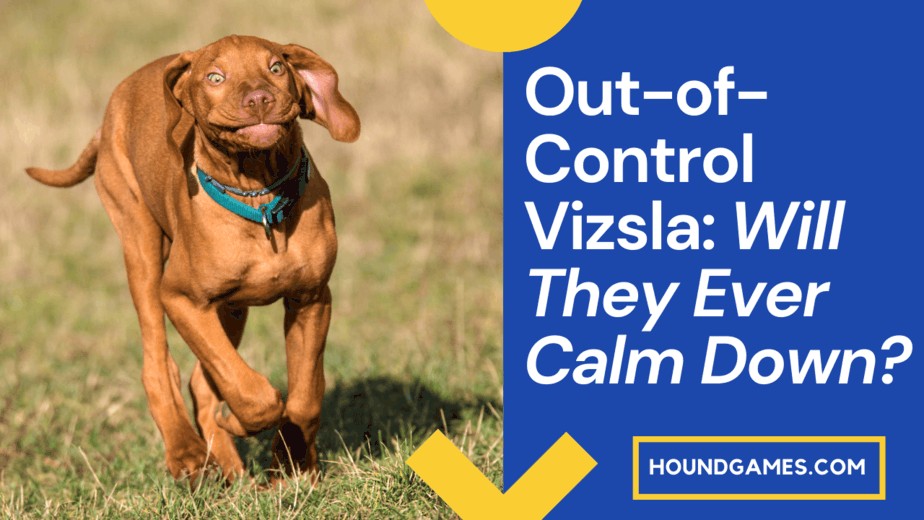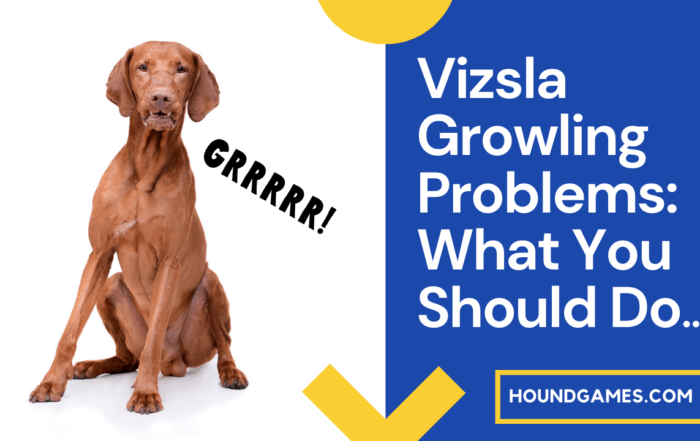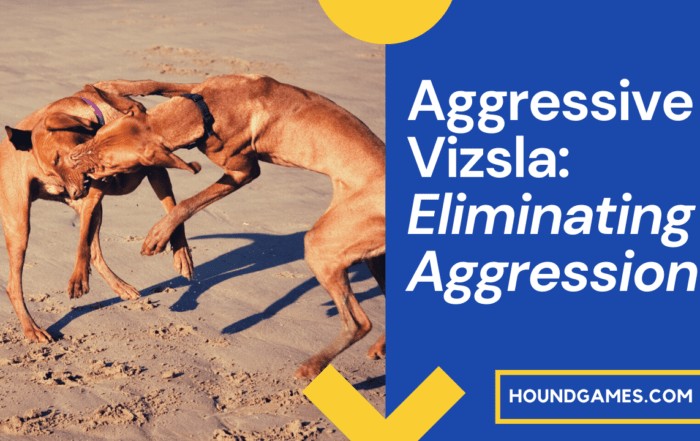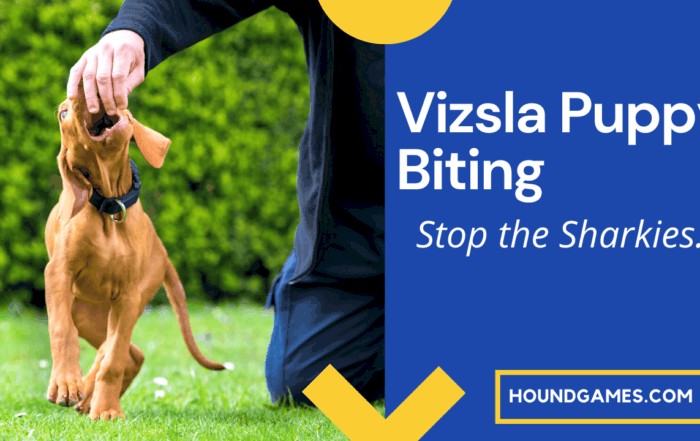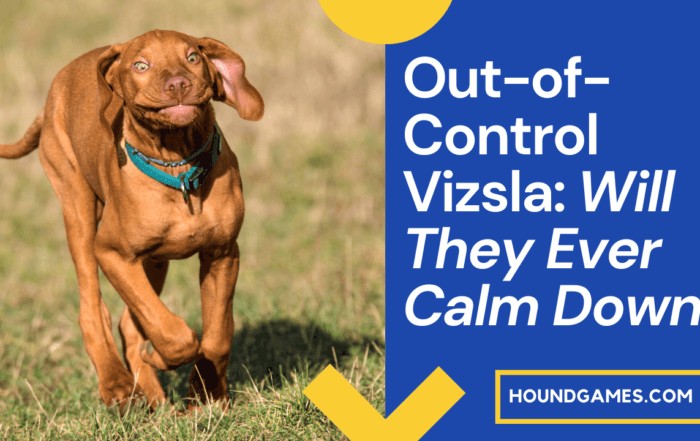When choosing a Vizsla, no doubt you were seduced by the parents’ noble, elegant good looks. But little did you know the zoomies they held within, waiting to be unleashed! So now you might be wondering at what age will my Vizsla begin to calm down and stop driving me crazy?
Vizslas are especially hyper when young, and all those frequent bursts of the zoomies have your Vizsla literally bouncing off the walls.
They never seem to want to just relax and calm down, rather they may be chewing on you or your furniture, making a mess whenever you leave, and just generally acting out of hand.
Luckily, some help is at hand!
At what age does a Vizsla calm down?
Like many hyper-active working dogs, the Vizsla usually only settles down into a mature and dignified adult between two and three years.
Generally, males seem to take a bit longer to reach emotional and mental maturity than females. So, be prepared for juvenile and clownish antics a bit longer if you have a boy.
That said, dogs are individuals, and some may quieten down after eighteen months or so.
On the other hand, Vizslas are known to be active hunting dogs well into their teens, and many have the stamina to work for long hours, even as seniors.
But if your puppy has just entered the teething phase and is mauling your favorite curtains or has just become a teenager and is using your house as a high-speed parkour course, don’t panic.
There are ways to calm your young Vizla down and make them easier to manage.
For a complete guide on calming down an unruly puppy, be sure to read our extensive post: Calm Down Your Crazy Puppy: A Complete Guide
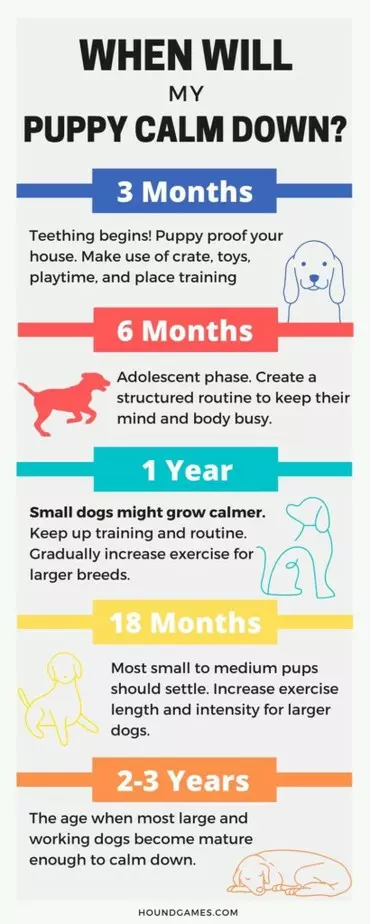
The Vizsla puppy survival kit: what you need…
- A crate (or multiple beds or elevated cots placed around the house)
- Chew and/or puzzle toys
- A leash and harness for structured exercise
- Their favorite treats
- A clicker
- A favorite toy (such as a ball)
Help! My Vizsla puppy is out-of-control: What to do?
To begin pacifying your Vizsla, you need to take a deep breath and approach the situation calmly and systematically. To start with, you need to identify the critical problem behaviors.
Some issues that are common in Vizlas are:
- Juvenile and neurotic destructive behaviors such as chewing and digging
- Separation anxiety
- Hyper-activity or refusing to settle down, even after playtime or a long walk
- A tendency to be timid or nervous, especially in some bloodlines
To deal with these issues, we need to understand that Vizlas are working dogs who do best when they feel like they have a job to do.
Secondly, they are extremely sensitive dogs who need positive reinforcement.
Any harsh language or treatment will be counter-productive with a young Vizsla. Instead, focus on following the below 5 step plan to bring your puppy back under control:
1. Frequent and structured daily exercise
Be sure to regularly exercise your Vizsla’s body and mind. If they’re still too young for long walks, be sure to play with them in the yard, and engage in games such as Hide and Go Seek (place treats around the house while your Vizsla waits, then let them loose. The sniffing also helps to exercise their mind).
Read our complete guide to puppy exercise here.
2. A clear daily routine
When your Vizla knows when to expect their exercise or training at a given time in the day, then they’ll be less likely to be asking for it when it isn’t coming. Routine is a way to establish expected downtimes.
3. Crate training and/or matt training
You want a location to send your Vizsla to when they’re out of control. A crate or play pen is ideal for this. Ensure it’s away from the hustle and bustle of your home, somewhere quiet, so they can settle down and even take a nap. Sometimes it’s a case of an overtired puppy!
4. Finding your Vizsla a “job,” such as bikejoring or field trials
As the Vizsla descended from hunting dogs, and are an excellent sporting and bird hunting dog, they love nothing more than a task! Be sure to spend time training them every day, as they will relish the opportunity.
You can also get them doing Nosework games, and other activities like fetch, tug, chase, and other fun games.
5. Teaching the “leave it” command to encourage appropriate chewing.
This command will come in handy more times than you’d imagine. Especially with a busy Vizsla puppy on your hands. Teach them this skill early, as it’ll make life easier for you.
All of this forms part of the seven critical steps for how to raise a puppy.
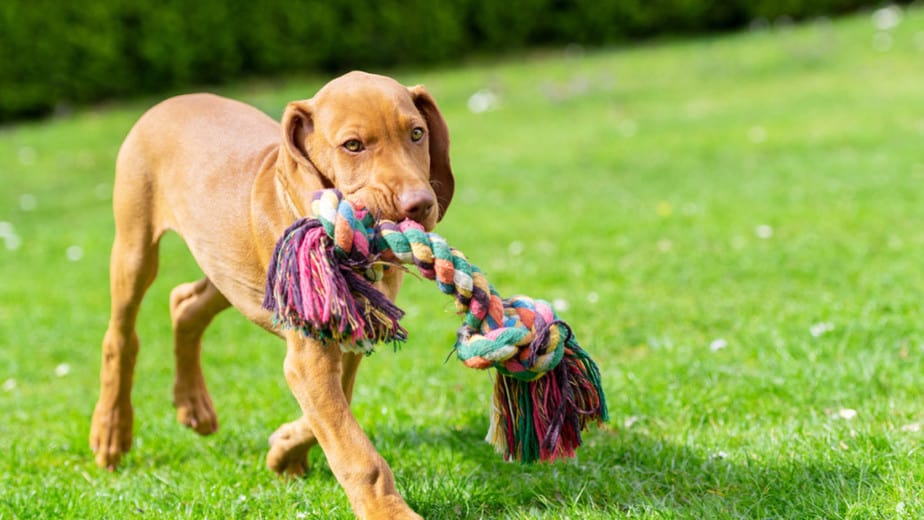
When your Vizsla puppy won’t stop biting
One of the most significant issues you may be encountering is that your Vizsla puppy is mouthy and simply won’t stop biting.
Many puppies learn bite inhibition from their parents and siblings. Still, Vizslas are particularly prone to gnawing on your fingers or nipping your heels as working and hunting dogs.
Not to mention what happens if they grab hold of your favorite pair of trainers. If chewing objects is a problem, redirecting with the “leave it” command and being ready to pass them an appropriate chew toy is the best remedy.
On the other hand, if your Vizsla won’t stop biting you, they need to be taught bite inhibition. This is relatively simple, but it requires consistency and a bit of patience.
Start by playing with your Vizsla and waiting for them to begin chewing or nipping your hands and arms. As soon as the puppy bites too hard, make a sharp, startling sound.
Say “ouch!” or “that hurt!” in a voice that is high-pitched enough to surprise your puppy so that they let go.
As soon as your puppy has released, turn and ignore them for 10 to 20 seconds. If they keep badgering you, keep turning away.
Only once your puppy is calmer you can resume playing. The consistent message you need to send here is that the game stops if you bite too hard. If you play nice, we will keep playing.
If this goes on for longer than fifteen minutes, you may begin to feel frustrated. This is then time to stop and call a timeout.
Return to the game when you are feeling relaxed and patient. Remember, persistence and positivity are key.
One method of stopping the immediate behavior is to ensure your Vizsla knows the command “Place”. It’s fast and effective and can be used to assist in controlling unwanted behaviors such as the sharkies! You can read about the command “Place” here where we go into detail about how and why it’s a good idea.
Never lose your temper. This will reduce your puppy’s trust in you and can make them nervous or more likely to act out. We also made a post on puppy biting called Puppy Biting: When does it stop? you may be interested in reading.
For more information about this topic, read our more in-depth look at Vizsla puppy biting, when it will stop, and what you can do to help.
Help! My Vizsla puppy won’t listen
Although Vizslas are intelligent and trainable, they are also easily distracted. They will often follow the scent or sight of something interesting rather than come when called.
If you are struggling with a puppy who won’t listen, start by reducing the number of distractions. This is a great time to introduce clicker training as part of your daily routine.
If your puppy is full of pent-up energy and can’t concentrate, try taking them for a walk first to quieten their minds. Then take them to a room where the only exciting thing is you.
Make sure you have a clicker ready, along with their favorite treats or favorite toy if they aren’t much motivated by food.
Remember:
- Set your dog up for success!
- Never ask them for anything you aren’t 99% sure they will do. It only teaches them to ignore you.
- Keep it simple and start with the basics.
To begin with, simply teach your puppy to associate the click with a reward so that they understand that the click means “well done!”.
After that, begin to condition your Viszla to look at you and reward for their attention. This is the most essential part of the training. Without learning to give you their undivided attention, nothing else can be achieved.
From attention, you can move to basic commands. Some general tips:
- Don’t repeat yourself. For instance, guide your dog into the sit position and say “sit” once their bottom hits the floor. As they become confident and reliable in the action, start adding the command gradually before they sit so that they learn what the word means.
- Don’t overdo it. A Vizsla puppy has an overactive mind. Keep training time down to between 30 seconds and three minutes to keep them from becoming bored. End while they are still eager.
- Always end on a good note. If they struggle with something, go back to the last thing they did well and praise them highly before completing the lesson with a precise term, such as “all done!”. Hold out your hand to show that there are no more treats.
- Be patient, and never train in a bad mood.
- Build expectations and training time gradually. Remember, a Vizsla takes a long time to mature and will benefit from a slow and steady increase in the amount of time they are expected to concentrate.
- Keep your Vizla’s favorite toys or treats on you throughout the day to reward good behavior whenever you see it. This makes training and shaping the actions you want part of your lifestyle rather than something you do for a few minutes three times a week.
Once your dog can listen in an environment without distractions, you can gradually move them to new areas, such as the garden, and add distractions as you go. Only once your dog is 100% reliable in the garden can you begin to test your dog in the great outdoors.
But be careful of asking for too much at once. A puppy who can do perfect obedience in your backyard may become simply too over-stimulated in a dog park to hear a word you say. So, try a quiet trail with easy commands and lots of rewards first
If your Vizsla is lunging at the face, you may be interested in reading Puppy Lunging: At Faces, Other Dogs, People
How do you discipline a Vizsla puppy?
Vizsla puppies respond best to a consistent routine and positive reinforcement. These are sensitive dogs.
You can read our guide to puppy discipline here.
Any kind of shouting, punishment or the use of negative reinforcement tools like e-collars will likely cause your Vizsla to become neurotic, nervous, or shutdown.
Instead, the first step is to establish a consistent routine. Your Vizla should know precisely when it’s time to get up when it’s time to go for a walk or play, and when it’s time to settle in the crate with a favorite toy to keep it occupied.
Beware of playtime that becomes overstimulating. An hour playing fetch may seem like a great way to tire your dog out. However, for a dog with boundless energy, this activity may be so exciting that they will struggle to settle down afterward.
Instead, try to follow up playtime with structured and disciplined exercises such as a long walk or hike.
Remember only to begin vigorous exercise such as bikejoring or running with your Vizsla once the vet has given all clear and confirmed that their growth plates have closed.
The last problem that often crops up with Vizslas is separation anxiety.
Vizslas are “velcro” dogs who do not like being left alone and can quickly become destructive if they are.
Studies show that early life experiences and a lack of exercise are the primary causes of separation anxiety. However, genetics does play a role in anxiety issues.
Aside from a calm, routine-filled homelife with sufficient exercise, place training is one of the best ways to teach your Vizsla that it’s okay not to be with you 24/7. It gives them clear instructions about what to do when you are busy with something else.
Like other training, place training is built up gradually and with plenty of rewards. You can use a crate or place appropriate mats or cots around the house for your dog to go to when you give them the command.
Toys will help keep them busy while they are in their “place” and give them specific times of day to settle.
Does your vizsla jump and bite at clothing? If so, you might like to read our post Is Your Puppy Jumping and Ripping Clothes? Do this…
Final Word
Vizslas are fun, boisterous clowns that are perfect for active owners. Their high-energy levels might make them a bit much to handle at times, but luckily where there is a will, there is a way!
A good Vizsla home will remember to laugh at the occasional “oopsie,” invest in positive and consistent training, and be prepared to spend a lot of time on exercise.
It may take a bit of trial error and a lot of patience. Still, the effort in creating the ideal Vizsla companion is entirely worth it.
Vizsla Growling Problems: What You Should Do
We have all been taught that a growling dog is a dangerous one, and this can influence how we react when our Vizsla puppy suddenly starts growling. This can certainly make us worry that our [...]
Aggressive Vizsla: Eliminating Aggression Guide
The Hungarian Vizsla is noble, lively, hyper-attached, and a devoted companion. That is until they aren't. Although aggression isn't typically a characteristic of a well-bred Hungarian Vizsla, certain bloodlines and some mistakes owners unknowingly make [...]
Vizsla Puppy Biting: How to stop the sharkies
Docile, sensitive, and gentle, the Hungarian Vizsla is the perfect dog for an active owner who enjoys regular exercise or field trials. So, new Vizsla puppy owners may be surprised when their bundle of love [...]
Out-of-Control Vizsla: Will They Ever Calm Down?
When choosing a Vizsla, no doubt you were seduced by the parents' noble, elegant good looks. But little did you know the zoomies they held within, waiting to be unleashed! So now you might be [...]

